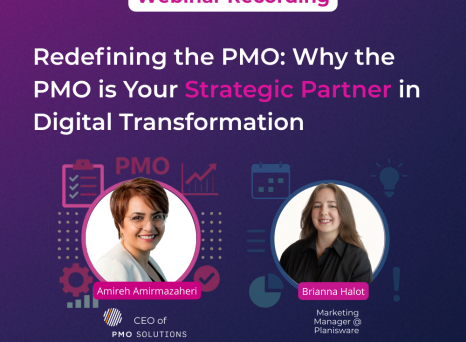What is a Project Management Office (PMO)?
A Project Management Office (PMO) is a group, unit, or department that defines and maintains standards for project management across an organization.
Playing many roles within an organization, largely depending on its size and the scope of projects, a successful PMO is a combination of good people, processes, and tools.
Depending on its maturity, the PMO can provide simple support services (administrative support and sharing of best practices), expertise on crucial project performance elements and metrics (e.g., estimations, scheduling, risk management, and quality assurance), and act as a consultant/advisor to project managers (including issues relating to HR). At its most advanced, a PMO can play a crucial role in strategic and performance-related decision-making.
But overwhelmingly its most common function, the PMO provides guidance and standards in the execution of projects. They create tangible goals, ensuring targets are met and projects are delivered consistently, on time, and within budget.
Further, PMOs play a key role in centralizing and coordinating management of projects, driving discipline and process improvement. Think of the PMO as your project support, sitting in the middle of a project team, offering structure and assistance. The type of PMO you have—supportive, controlling or directive—dictates the level of authority and involvement they have.
It’s worth noting that PMOs aren't compulsory for project management. If you're a small operation, for instance, you may be able to manage without a Project Management Office. But as companies seek to deliver more products, services, and capabilities, the value of a PMO to large and mid-size companies has become more evident—89% of organizations report having at least one PMO.
If your organization runs multiple cross-functional projects (for example, several projects with interdependencies or projects involving different departments) at the same time, then you should consider implementing the role in your business.
Whilst they can be outsourced and external, PMOs are more commonly internal and should reflect the organization’s culture and be aligned with its overall vision.
What are the different types of PMO structures?
While not an exhaustive list, supportive, controlling, and directive are the most common PMO classifications. These structures define the characteristics and level of control each PMO has.
The supportive PMO
The supportive model provides “a consultative role to projects” and works best for organizations with low project management maturity. This role includes registering products and resources, standardizing tools, and supporting the wider PPM team(s).
While the supportive PMO does not exercise huge control over projects, it ensures best practices are followed. This type of PMO delivers advice for new projects based on insights from older projects.
The controlling PMO
The controlling model has the same consultative responsibilities as the supportive model, but also ensures compliance, data quality, and validating stages within the project lifecycle.
A controlling PMO has the authority to enforce project management best practices, making this model suitable for organizations with a higher level of project management maturity or who already have the supportive model.
The directive PMO
This is the model with the highest level of control. The directive model heavily controls resource and project management and oversees project, program and product managers.
Organizations with a higher level of maturity or that already have the supportive or directive model in place will benefit from the directive PMO model. A directive PMO typically acts as a centralized authority, assigning project managers to projects and being accountable for all results.
There are many things to consider before selecting a PMO. If it doesn’t align with your business objectives, you can course-correct and find a model that suits you better.
Several factors will influence which PMO type is right for you. These include:
- Industry
- Organization size
- Existing PMO structure and maturity
- Anticipated PMO function
Our eBook dives deeper into the multiple considerations involved in selecting a PMO type, but these are a few examples of types of PMOs and the PMO structure they might adhere to.
- A Business Unit PMO, also known as a Departmental PMO, that delivers training and resources to a specific division will suit a Supportive structure.
- A Strategic PMO that aligns project deliverables with business goals may assume a Controlling function.
- A PMO that closely controls budgeting manages project leads, and defines and deploys data quality processes will likely perform a Directive role.
The key benefits of a PMO
PMOs are essential for driving projects forward; they provide deployment support and ensure continual process improvement, benefitting your project execution in many ways. It’s no wonder that 89% of high-performing companies have at least one.
- Standardization of methods and processes, providing project managers clearer guidance for efficient execution. As well as ensuring consistency of delivery, standardization helps management teams to access performance.
- Increased transparency and visibility into your team and resource capacity needs, which can help to limit information silos and miscommunications.
- Better project maturity, quality, accountability, and democratization, ultimately keeping more of your projects on time and your team on the same page.
- Closer alignment with the C-level, particularly in regards to organizational goals. In turn, this helps to direct and prioritize projects delivering the biggest long-term benefit for the organization.
- Strengthened decision-making for management, through access to extensive project data and real-time insights on project and portfolio performance.
- Accurate and aligned budget and resource allocation, which can help to satisfy executives and keep the overall project portfolio in check. Standards set by a PMO can create more accurate results, giving a clearer idea of project length, budget, and resources.
- A reduction in project failure, overspending, and client dissatisfaction through standardized templates and tools, and continual monitoring.
- Reduced costs, through a more accurate, real-time understanding of project budgets and resources. Improved quality and consistency of projects also minimizes the risk of revisions.
- Higher project completion rates through a focus on deliverables and back-end process standardization.
- Training and education provided the PMO, serving as your central knowledge hub. This can help to hone project management skills and identify top talent within the organization.
5 key roles, responsibilities, and functions of a PMO
Now, let's dive deeper into the specific responsibilities of a Project Management Office.
1. Standardization of the project management process
The PMO's main objective lies within the creation and standardization of methods, processes and tools.
Ultimately, they're responsible for creating templates and processes and teaching people how to use them. It's incredibly important that project teams use the same tools, templates and processes for the right function.
Templates the PMO may create include:
- Project proposal template. When approved, this helps project managers understand the agreed plan and avoid scope creep.
- Project status report template. This documents how the project's progress will be reviewed and measured over the course of its implementation. As the project moves forward, the PMO will also collate 'lessons learned' and integrate them into the project processes. This helps to improve future projects.
- Project change request template. If necessary, a PMO may draft this document to help project managers capture change requests throughout the project lifecycle (and assess their impacts).
- Project closure report template. This document enables teams to assess finished project and determine what went well and what didn't. It's also an opportunity to compare the 'before and after' of costs, timescale and scope.
To better coordinate the entire project implementation process, a PMO may choose to adopt a Project Portfolio Management (PPM) tool. This will encourage consistent processes across project teams, and offer real-time visibility into the project portfolio. It'll also discourage the likelihood of 'shadow IT' and avoid any siloed processes.
2. Support project implementation
'Operations keeps the lights on, strategy provides a light at the end of the tunnel, but project management is the train engine that moves the organization forward.' - Joy Gumz, project management thought leader
A successful project relies on team-wide support, tailored training and open communication.
Here, a Project Management Office will:
- Assist with and problem-solve specific issues, such as planning or allocating resources. (And get off-the-rails projects or struggling teams back on track.)
- Help project managers choose the right methodology for their project or help them to build a business case.
- Facilitate communication and collaboration throughout the project team and stakeholders, ensuring everyone's on the right page.
- Provide accurate and reliable information to allow stakeholders to make the best possible decisions when circumstances dramatically change
- Mentor and train project managers to make sure they acquire the right skills, as well as recommend online project management courses.
The PMO often acts as a project's 'first responder', using their experience to spot issues, offer advice, and resolve problems.
In some situations, they may also help to find software that isn't covered by their 'standard suite' of tools. In many cases, this refers to specialist software or prototype situations.
3. Provide a consolidated view of all projects
Project stakeholders and decision-makers need to know the ins and outs of your projects. Without full understanding, they'll struggle to make the right decisions.
On the flip side of this, at the intersection between strategy and execution, PMOs must also familiarize themselves with what's actually going on within their company. (Particularly in relation to the executives and decision-makers they want to please.)
To bridge the gap between projects and their stakeholders, PMOs provide thorough reports and dashboards tailored to their executives' needs.
This means your PMO must:
- Design and follow up on Key Performance Indicators (KPIs). This includes KPIs on the overall health and progress of individual projects, as well as overall project performance. They may also generate OKRs, should their company use them. These will outline key goals for each project, as well as the PMO department (or individual) at large.
- Communicate clear information around budgets, forecasts, actuals, and margins across the whole portfolio of projects.
- Consolidate all information and documents correctly and build a project dashboard specifically for stakeholders. If necessary - and with the right tool - a PMO may build configurable reports tailored for each category of stakeholder. This will ensure they have the right, valuable information at the right time.
- Provide timely, accurate insights. Real-time data is essential for any project reporting. The longer it takes to curate and deliver a report, the less valuable the information.
With the right project management platform, you can bring your stakeholders together and offer them real-time, tailored insights into your projects. This allows them to access important data, reports and project priorities from one single source of truth.
4. Plan and schedule resources efficiently
PMOs allocate resources based on project priority and, ideally, its impact on the overall business. They have the ability to anticipate the resources needed for a project and, in turn, optimize the use of the most expensive resources, whether it be a wind tunnel or a high-tech lab.
To make this optimization as accurate as possible, PMOs need to prioritize capacity planning. To help them do this, they must be able to run simulations, scenarios and what-if analyses. Of course, they'll need a project management tool with this feature built-in.
5. Strategic portfolio management and governance
(SPM) aligns your project execution with your organization's strategic vision. A PMO steers the SPM ship, ensuring all resources, projects and budgets align with your higher goals.
By scoring projects using predefined criteria, a PMO narrows down their projects, and selects the best initiatives according to the goals of their organization. PMOs then advise senior management or C-level leaders to select candidate projects that best align with the strategic goals of the company, by providing a sound business case and a clear cost/benefit ratio.
In addition to this, the PMO also monitors the overall risk of a project. This isn't confined to risks concerning employees, but rather risks to the entire company, such as compliance issues or negative exposure. From here, they build mitigation and prevention plans for future 'risky' projects.
What will the PMO of the future look like?
Now, let's look beyond the typical responsibilities of the current PMO. What does the future hold in store for the PMO?
The role of the Project Management Office is growing larger year on year, with more organizations noting the value of a central hub for Project Portfolio Management. In fact, it's thought the 'PMO of the future' will play a bigger role in top management.
But what exactly can we expect to see in the years to come?
Many changes to the Project Management Office will be triggered by the challenges they face today. These include:
1. The 'Agile' PMO
Agile projects have a much higher success rate and lower failure rate in comparison to traditional approaches, such as Waterfall.
As a result, many PMOs will move away from the "command and control" posture of traditional methods and instead adopt Agile approaches. This will inevitably come with a mindset shift, particularly for PMOs who have yet to work with more flexible methods.
These Project Management Offices will need to learn best practices around Agile delivery, governance and management.
2. A mixture of methodologies
On that note, however, traditional phase-gated frameworks will still have their role within the PMO.
As such, we expect to see a 'hybrid' middle ground. The future PMO will manage a mixture of project methodologies, such as stage-gate and Agile.
To consolidate their portfolio of projects, support teams, manage dependencies and report the right data, they'll need to find a central tool that offers a complete bird's eye view.
3. The 'digital' PMO
The move to remote working has its many benefits—such as increases in productivity and employee wellbeing—but it will also impact the day-to-day of the PMO.
With a shift to a digital-first approach, many PMOs will have to rely on software that'll not only bring their project portfolio together but their teams, too. This will involve a change in culture and communication.
4. Bridging strategy and execution
As the emphasis shifts from individual projects to wider portfolios, PMOs will have to manage projects based on company priorities. This involves an alignment with wider organizational goals.
Strategic Portfolio Management (SPM) is a concept coined by Gartner. Ultimately, SPM aligns your project execution with your organization's strategic vision.
This is key for the PMO of the future—many project management leaders will have to build upon their strategic competencies.
For PMOs looking to bridge the gap between strategy and execution, they'll need to find a platform with the right SPM capabilities built-in.
Planisware, for example, allows you to build strategic roadmaps, define investment targets, and measure progress through KPIs and OKRs. After PMOs score projects using predefined criteria, senior decision-makers can then select candidate projects that best align with the strategic goals of the company.
Planisware can help you to build a world-class PMO, transforming how you strategize, plan, and deliver on your organization’s mission.





